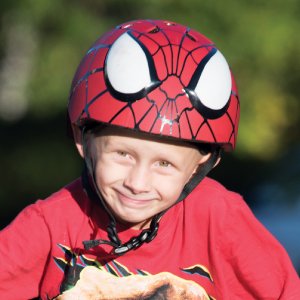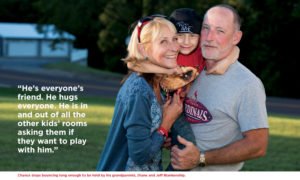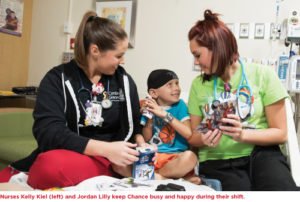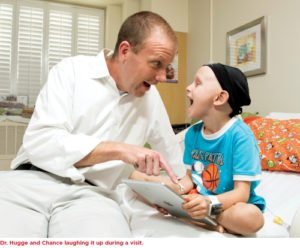Our Patients:
Chance Wunderle

Chance Wunderle, again, had been asking for it. “He always wants to play,” says the tickler, Kelly Kiel, R.N., a nurse who has been taking care of Chance through the summer and fall. “He’s everyone’s friend. He hugs everyone. He is in and out of all the other kids’ rooms asking them if they want to play with him.”
Only a few months ago Chance was zooming through his fifth year and a summer of swimming, bicycle- and scooter-riding and learning to play baseball, soccer and hockey.
“He plays from sun up to sun down,” says Jeff Blankenship, his grandfather. “He never stops.”
Chance’s athletic development hit a bump on one Sunday last June, however.
“We noticed a lump on his leg – the outside of his left thigh. It was about six inches long. It wasn’t painful but it went almost from his hip to his knee,” Jeff says. “We took him to his doctor on Monday and on Tuesday we were here.”
For Chance, “here” has been SSM Health Cardinal Glennon Children’s Hospital. At the Costas Center his lump was diagnosed as rhabdomyosarcoma, a cancer of connective tissues that normally develop into muscle.
Rhabdomyosarcoma mostly occurs in children and accounts for three percent of childhood cancers, according to the American Cancer Society. About 350 new cases are diagnosed in the United States each year.
“Fortunately all pediatric cancers are pretty rare. We probably have a couple of cases of rhabdomyosarcoma here a year,” says Christopher Hugge, MD, of the Costas Center. He is an assistant professor in hematology-oncology at Saint Louis University School of Medicine and has been Chance’s oncologist throughout his treatment.
“Chance has a fairly aggressive form of the tumor. Fortunately it was well localized. He is getting about a year of chemotherapy in transfusions every two to three weeks,” says Hugge. “His chemotherapy is intense. It affects his immune system and causes some nausea, vomiting and hair loss. He has had some occasional infections and fevers and needed some blood transfusions.”
The Costas Center and the 4 North in-patient Oncology wing at SSM Health Cardinal Glennon have been Chance’s second and third homes this year. Since the lump on his leg was removed in the operating room he has alternated short and long visits to the hospital for chemotherapy – a one-night admission or a daytime Costas Center visit, followed the next week by several days on 4 North.
Chance maintains an astounding energy level despite chemotherapy, his doctor and nurses have found. Their descriptions of him often include some form of the verb “bounce.”
“Kids generally do better than adults and younger kids do better than the older kids,” Hugge says. “Chance seems unnaturally resistant to the side effects of chemotherapy. Even when he has an infection or is profoundly anemic, he often is bouncing around the Costas Center or 4 North. He is hard to knock down.
“Chance has been here from one day to one week at a time, but there are other kids who are here for 30 days or more,” Jeff says. “The majority of the time he doesn’t complain much about coming here. Everybody who takes care of him makes sure that he stays busy and gets everything he needs. They try to entertain him.”
Chance is comforted by familiar faces every time he is in the hospital. “His favorite nurses were Lindsay 1 and Lindsay 2,” his grandfather says. “Then there were two Michelles. They are so good, so nice. They care, they genuinely care. They want to take good care of him and they want to make sure he is happy. They are always asking me if I need anything, so they are taking care of the parents, too.”
It seems that Chance quickly adopts every nurse. On her first day on 4 North Jordan Lilly, GN, was named one of his favorites.
“He’s not shy all,” Kiel says. “Most kids are pretty shy until you pull them out of their shells. As soon as you meet him, he’s asking, ‘What’s your name? Are you going to take care of me all day? Are you going to be here tomorrow?’”
Chance has bonded with his doctor, too, giving Dr. Hugge a nickname early in treatment.
“One day he told Dr. Hugge, ‘I’m going to call you Dr. Morocco,’” Jeff says. “I don’t know where Chance came up with that, but Dr. Hugge seems to like it.”
“He’s a lot of fun,” Hugge says.
“The fourth floor is where some of our sickest patients stay, sometimes for two weeks and sometimes for two months,” says Sandy Koller, executive director of SSM Health Cardinal Glennon Children’s Foundation.
Each year about 70 children in the greater St. Louis area are diagnosed with cancer and come to the Costas Center for treatment. The physicians and scientists at SSM Health Cardinal Glennon and Saint Louis University School of Medicine are trained and equipped for the latest cancer therapies. Their specialties include pediatric hematology-oncology, pediatric surgery, neurosurgery, tumor orthopaedic surgery, radiology, radiation oncology and clinical pathology.
The center’s physicians are members of the Children’s Oncology Group, a network of children’s hospitals sponsored by the National Cancer Institute. The affiliation provides access to the most current treatments for childhood cancer, including investigational new therapies when appropriate for certain patients.
Patients with blood disorders, such as sickle cell disease, hemophilia, anemia, immunodeficiencies and severe combined immunodeficiencies (SCIDS), also visit the Costas Center and stay on 4 North.
The 16-bed 4 North unit is part of the hospital building that opened in 1956. Most of that original building has been renovated and much of the hospital’s square footage is now located in the South and West towers built within the past 20 years.
Oncology patients take up some of the hospital’s longest-lasting residencies.
“It can be a home away from home. Some of the kids decorate their rooms so they no longer look like hospital rooms,” Hugge says. “Some of the kids come in for just a couple of days or receive IV fluids overnight. We have had kids here for a month or two. Patients newly-diagnosed with leukemia need to stay until their blood counts recover. Some patients may have severe infections so it takes them a long time to recover.
“We are in the older, original part of the hospital. There are not too many places in the hospital that have not been renovated,” he says. “These rooms were built with shared bathrooms for the most part. We train the families of oncology patients to ward against infections because their children have compromised immune systems, then we ask them to share bathrooms.”
The Cardinal Glennon Children’s Foundation and SSM Health are making plans to renovate 4 North, Koller says.
“The Costas Center was redesigned a couple of years ago. The goal is to renovate 4 North so each patient room is larger and has a private bathroom. There will be a sleeper sofa in each room for parents who would like to spend the night with their child. There is a big need for privacy because these kids are in the hospital for so long with their families, and the patients often have to stay in their rooms due to infection risks while they are receiving chemotherapy,” Koller says.
In the current configuration restrooms are shared by adjoining patient rooms. Also, she says, “Right now there is only one tub on that floor and all of the kids share that. Cleanliness on this floor obviously is very important because infection control is so crucial for these patients.”
The reconfigured unit will hold more space for amenities, too. “We are redesigning the playroom along with the parent lounge,” Koller says. “We will have more room so parents can have a place go to have a few minutes away to rest.”
Chance’s grandmother, Diane Blankenship, wholeheartedly casts her vote for the improved sleeper sofas that will await parents on the remodeled 4 North. “After a week of sleeping on this folding couch my back aches.”
While Chance’s grandparents are impressed with the quality of care they receive at the hospital, “It is very cramped in these rooms,” Jeff says. “There is the patient bed, a little desk and a little end table and a chair that turns into a bed for parents.
“By the time you get that bed set up for the night, it is crowded. Then you have to break the bed down every single day and put it back together at night. Sometimes both parents want to spend the night when they have a very sick baby. They can’t do that. My wife and I switch nights so we can stay with Chance,” he says.
Some of the existing fixtures are not kid-sized, he adds. “The bathrooms were made for adults. There are some teenagers admitted to the floor, but the majority of the kids are less than 10 years old. The hand towels are hard for them to reach. How well can a kid wash his hands in a three-and-a-half-foot-tall sink when he is only three feet tall?”
Chance shows no sign of slowing down before his chemotherapy ends its course next year.
“Very rarely do we see him when he is not bouncing around,” Kiel says. “His last admission was for a fever. He was still running around the hallways and playing on his iPad and watching movies. I thought, ‘Are you sure you have a fever?’”
“I asked Dr. Hugge how we would know when his blood counts are getting low,” Diane says. “Dr. Hugge said he will get dark circles under his eyes and he probably won’t feel like doing anything.”
But Chance has come to the Costas Center full of energy despite low white blood cell counts that would keep an adult in bed, Diane says. “That child is always wild and crazy. I wish he could share some of that energy.”
After a pause, she seems to think that Chance does share his energy. “He is contagious. He makes you happy. When he was a baby he would talk to everybody he saw in the grocery store. He never sees a stranger.”
Even at his age Chance already has attained citizenship in St. Louis Cardinals Nation, the fictional homeland of Redbird fans. When he had a chance to meet Matt Holliday in the Costas Center earlier this year, Chance knew he was the Cardinals’ left fielder and asked him if he hits a lot of home runs.
“We sit on the couch and watch TV all the time. I ask Chance what he wants to watch and he says ‘the Cardinals’, Jeff says.
We watch the game and talk about the players. One day when I wasn’t at the hospital but my wife was and Chance was called into the Costas Center to have his picture taken with Matt. That was awesome.”
Holliday, unfortunately, suffered a leg injury of his own this year and spent weeks on the inactive list. It gave Chance an idea, says his grandfather.
“We sent Matt a card about two weeks ago to wish him a speedy recovery!”


